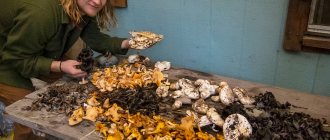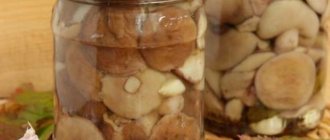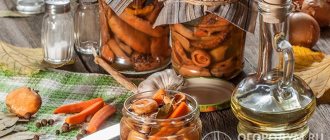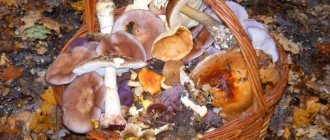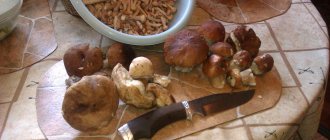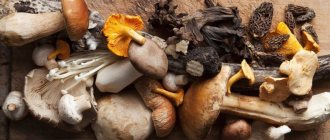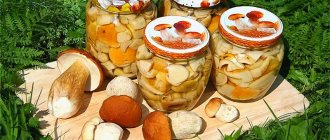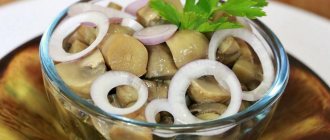Every lover of “silent hunting” knows that there are mushroom species that are quite difficult to find. These include sandpiper mushrooms. You should try very hard to find them under the foliage or in the pine needles and sand hills.
However, the efforts are not in vain. These rare representatives of the mushroom world are distinguished by their special taste, characteristic smell and a considerable amount of useful substances. You just need to know where to look for a delicious type of mushroom, how to distinguish edible specimens from poisonous ones and be able to cook them correctly.
general characteristics
Sandpipers are not very popular mushrooms. They are rare, and not all mushroom pickers know how tasty they are. When prepared correctly, they resemble truffles and are sometimes even called “Russian truffles.”
Sandpipers include about 40 species of mushrooms, differing in size, color and habitat. They all belong to groups 3 and 4, considered conditionally edible, in some countries - inedible. But among them there are very tasty ones, although edible species are rare. This is a sandpiper or poplar row mushroom. It has many names: poplar, podtopolnik, sandstone, sandpiper, and popularly these mushrooms are also called poplars, frosts or zabaluiki.
These mushrooms got this name because they prefer sandy soils. They grow most often under poplars and form mycorrhiza with these trees, penetrating into the roots. They bear fruit from the beginning of leaf fall until the first snow. Sandpiper is a lamellar mushroom belonging to the family Ryadovaceae or Tricholoma, the genus Ryadovka. Reproduces by spores.
In places of distribution it grows in large groups and is quite productive. If one mushroom is found, there will definitely be others nearby at a distance of up to half a meter. They grow in rows or form so-called “witch’s” circles, occupying a vast area. Rows are often arranged from small young fruits to older ones. They stretch for a long distance, crossing fallen trees and stumps.
Sandpiper (Tricholoma populinum)
Topolyovka
poplar sandpiper
Sandstone
The Sandpiper mushroom belongs to the lamellar mushrooms, which means that it reproduces by spores found in its plates.
Description
When young, its plates And, as the mushroom grows, they change their color to pinkish-brownish.
His hat The diameter of the cap varies from 6 to 12 cm. Under the skin of the cap, the flesh is slightly reddish.
The stem of the poplar row is of medium size, rather fleshy, cylindrical in shape and solid inside, with a flaky-scaly coating, fibrous and smooth, pinkish-white or pinkish-brown in color, covered with brown spots when pressed.
The flesh of the mushroom is fleshy, soft, white, brownish under the skin, with a floury taste.
Spreading
Sandpiper grows from August to October in large groups (entire ridges) under poplars, deciduous forests with a predominance of aspen, and can be found in plantings along roads and in parks. Distributed in the European part of Russia and Siberia. The mushroom has a pleasant aroma of fresh flour.
Sandpiper mushroom got its name for its ability to grow under poplars and in close proximity to them, during the autumn leaf fall. Sandpiper, at a young age, is a little similar to the crowded rower in color and shape, but, unlike it, it is much larger in size and has a slightly bitter taste due to the fact that it grows in such conditions that the cut mushroom is almost completely covered with sand or small debris. It can also be confused with the poisonous tiger rower. But they are distinguished by two main features. Firstly, Sandpiper always grows in large groups and, secondly, it always grows close to poplars.
Edibility
In terms of its taste and consumer qualities, Sandpiper belongs to the edible mushrooms of the fourth category.
Sandpiper is a completely edible mushroom, but only after it has been washed, soaked and boiled to remove bitterness. The sandpiper grows in deciduous plantings under poplars, well covered with fallen leaves, always in large colonies. Poplar rows are common wherever poplars grow - these are the territories of North America and Canada, Western and Eastern Europe, Central Asia, as well as central and southern Russia, the Urals, Siberia and the Far East. Its main growth period begins during the autumn leaf fall season, around the end of August, and ends at the end of October.
Poplar row is eaten exclusively in salted or pickled form after thorough washing, soaking and boiling.
Video about the Sandpiper mushroom:
Distinctive features
Various other types of mushrooms can grow on sandy soil: boletus, violin mushrooms, saffron milk caps, chanterelles, champignons. But poplar rows are usually called sandpipers. They have several characteristic features:
- compact, beautiful in shape, straight leg;
- there is no tubercle in the center of the cap, the color is lighter at the edges;
- They always grow in large groups; you can collect several buckets from one clearing;
- prefer sandy soil under poplars;
- hide in the ground, under leaves;
- the aroma of the pulp is pleasant, mealy or cucumber;
- The color of the pulp is pinkish, creamy, but not white; it darkens at the break.
Description of appearance
The sandstone mushroom is medium in size. The leg is up to 10 cm high, the cap is up to 15-18 cm in diameter. It belongs to the lamellar type, the spore powder is initially white, but as the fungus ages it turns brown. The poplar row has several characteristic appearance features by which it can be distinguished from other species.
- The cap of old mushrooms is spread out, flat, unevenly curved, and has a depression inside. Diameter is 6-12 cm. In young fruits it is spherical and convex. It gradually straightens out, but the edges remain curled. Often cracks appear on them. The color is yellow, pinkish-brown or beige with brown spots. The surface is dry, but with increased humidity it becomes sticky or slippery.
- The lower surface of the cap is lamellar, white or cream. It darkens with age, the color approaches the color of the cap. The plates are thin and frequent. They darken when touched.
- The flesh is pale, pinkish, elastic and soft. The smell is reminiscent of flour, sometimes there is a faint cucumber aroma. The taste is slightly bitter and mealy. Both the cap and the leg are fleshy and dense.
- The leg is short and thick, reaches 4 cm in diameter, with an average height of 5-7 cm. It is fleshy, straight, almost even, with only a slight thickening at the bottom. The color is milky white or pinkish brown, but darkens when pressed. There are darker scales on the surface. Inside the pulp is fibrous and dense.
Answers to common questions
Sandpipers are very common mushrooms, so they often become a topic of discussion among mushroom pickers:
How to distinguish an old sandpiper from a young one?
The age of sandstone can be determined by its cap. In young people it is convex, and in old people it is prostrate.
What taste do mushrooms have?
Raw rows have a bitter taste. However, with heat treatment the bitterness goes away.
How long should sandboxes be soaked?
Sandstones must be soaked for 24 hours in salt water. During this time, the pores open sufficiently, and the sand completely comes out of the mushroom plates.
Is it possible to grow sandpipers at home?
Sandpipers can be bred at home if you follow a certain growing technology. The main condition is sandy soil.
Sandpipers are a very common mushroom that can be prepared in a variety of ways. The only difficulty may arise during collection, since the mushrooms have inedible counterparts.
Varieties
All sandpipers are similar in appearance, differing only in the color of the cap. Of the several dozen varieties, the most popular besides poplar are three species. They are most often classified as conditionally edible. But there are many lovers of these rows, since when properly prepared they can be used to make delicious dishes.
Green row
The greenfinch got its name because of the greenish color of its cap and legs. It does not disappear even after prolonged heat treatment. Before cooking, soak well in salted water and boil. When consumed in large quantities, greenfinch can be toxic and affects skeletal muscles.
The cap is convex, with a small tubercle; in old mushrooms it is spread out, with a raised edge. The color is yellow-olive or greenish-yellow, brown in the center. The plates are frequent, yellowish or greenish. The leg is short and thin, thickened at the base, covered with brownish scales.
Greenfinches prefer sandy soils in pine and mixed forests. They grow singly or in small groups.
Gray row
The gray sandpiper is similar in shape to the poplar, but has a mouse-colored cap. Because of this, it is the most difficult to find in the forest, and mushroom pickers pay almost no attention to such inconspicuous mushrooms. But they are tasty and have high nutritional value, you just need to boil them well.
The cap of the gray sandpiper is spread out, in the middle there is a small tubercle, in the center it is colored darker. The leg is thin, sometimes curved. The pulp is fleshy, yellowish in the stem, with a slight powdery odor. Prefers coniferous forests, often forming mycorrhizae with pine trees.
Row yellow-red
The red sandpiper is also called the yellow-red or red honey fungus. It has a characteristic reddish cap color. On top it is covered with purple scales. The plates are yellow. The stem is thin, curved, also yellow-red in color, and hollow in the old mushroom. It is found in coniferous forests, growing on stumps and dead wood in groups of 3-4 pieces. Fruits from July to September.
The shape is the same as other sandpipers, only the flesh is yellow. Refers to conditionally edible. The pulp is bitter, with a sour odor. Therefore, first you need to soak it for at least a day, then boil it, only after that you can cook it.
Edible or not
Poplar rows or sandstones are delicious, completely edible mushrooms. Although not all mushroom pickers take them, preferring the more common ones. They have a sweetish, nutty flavor and a delicate mealy aroma. By properly preparing these mushrooms, you can get unusual healthy dishes that are aromatic and tasty. When fried, they resemble truffles. Salted and pickled sandpipers smell pleasantly like fresh cucumbers.
Sometimes in the literature poplars are called conditionally edible. You may find recommendations to soak the fruits for a day to get rid of bitterness. But in fact, this is not necessary, they have a pleasant aroma and taste like truffles. The bitterness is almost not felt; to get rid of it, you just need to remove the skin. Poplars can be fried, boiled, pickled, and salted. They are used to make soups, sauces, pates, and caviar.
The only downside to eating them is related to the soil in which they grow. Sand grains often get clogged into the plates. Therefore, it is recommended to rinse the collected fruits well before cooking and then soak them to get rid of sand. But if the mushroom is clean, you don’t have to do this.
Taste qualities of the row
In general, it should be said that in terms of taste, row mushrooms are, of course, inferior to many mushrooms, primarily porcini, aspen, boletus, saffron milk caps, boletus, champignons, and chanterelles. Therefore, often even experienced mushroom pickers, who know well that these are edible mushrooms, do not collect sandpipers on principle. However, there are also mushroom pickers who like both the original “floury” aroma of such mushrooms and their sweetish taste.
- Number of servings: 2
- Preparation time: 20 minutes
- Cooking time: 20 minutes
Distribution area
Sandstone mushrooms are quite rare mushrooms; they are not found in all countries, usually in the steppe and forest-steppe zones. They grow in regions with temperate climates: Canada, North America, Asia, Europe. In Russia, they are especially common in the Voronezh, Volgograd, Rostov and Saratov regions, Kazakhstan, Altai Territory, and Siberia. They prefer deciduous and mixed forests. But they grow only on dry, loose soil, often on sandy soils, which other mushrooms do not like.
They are found mainly under trees, preferring poplars, aspens, and conifers. But you can find them in open areas, on the edges, along roads, near tree stumps, along the banks of rivers and ravines. It is difficult to detect them, as they like to camouflage themselves by hiding in the ground. The hats are always covered with sand, covered with blades of grass and leaves.
Calorie content of foods possible in the dish
- Forest mushrooms – 21 kcal/100g
- Cloves – 323 kcal/100g
- Sugar – 398 kcal/100g
- Granulated sugar – 398 kcal/100g
- Wine vinegar (3%) – 9 kcal/100g
- Vinegar – 11 kcal/100g
- Vinegar 9% – 11 kcal/100g
- Balsamic vinegar – 88 kcal/100g
- Apple vinegar – 14 kcal/100g
- Black peppercorns – 255 kcal/100g
- Salt – 0 kcal/100g
- Water – 0 kcal/100g
Calorie content of foods: Mushrooms, Water, Vinegar, Sugar, Salt, Peppercorns, Cloves
How and when to collect these mushrooms
Poplars grow in parks, forest plantations, meadows, and along roads. But it is recommended to collect them in forests far from the city and busy roads. Sandpipers are difficult to find. You need to look closely, because they are hiding. It is recommended to dig out all the hills and mounds of sand and leaves; it is in such places that poplars live.
They do not completely break through the turf, but only lift it, so tubercles are formed, sometimes only brownish semicircular caps are visible on the surface. Often the fruits have to be dug out from under the ground. Some amateurs, knowing this feature, go out for “silent hunting” in shoes with thin soft soles, through which you can feel the hard caps under the layer of soil.
Not everyone knows when to pick sandpiper mushrooms. They are late bloomers, growing from the end of August. They bear fruit during the entire leaf fall period - until the end of October, sometimes until the first snow. It is better to take young fruits that have not yet completely emerged from the ground. They have higher nutritional value, are less damaged by worms and are more suitable for harvesting. You should not take damaged fruits with yellowed flesh. You need to cut them off carefully, then more mushrooms will quickly grow in this place. If you damage the root system, you can destroy the entire family.
Differences from inedible counterparts
Among the rows there are many inedible and poisonous. Therefore, when picking, you need to carefully examine the fruits, paying attention to their distinctive features. If there is a slight doubt, it is better not to take such mushrooms so as not to get poisoned. Some types of russula and talkers are similar to poplars. But it is easiest to confuse them with several types of false rows.
- Leopard or tiger row is toxic. You can recognize it by the scaly gray spots on the cap. The plates have a yellowish or greenish tint. The pulp is grayish and does not change color. There is also no flour smell.
- Pointed mouse row is slightly toxic and odorless. The leg is thin, the cap is cone-shaped, and there is a sharp dark protrusion in the middle.
- The shape of the soap row is very similar to a sandbox. But it has an unpleasant soapy-fruity smell. The flesh turns red when cut.
- The brown row also turns red when damaged. In addition, it emits a strong unpleasant odor.
- The poisonous one is the yellow sandpiper mushroom, called the sulfur-yellow mushroom. By color it can be confused with greenfinch. But its distinctive feature is a sharp unpleasant odor, similar to tar or acetylene. This species also has sparse, thick plates.
- In addition to its color, the white rower differs from sandpipers in the wavy thick edges of its cap. The pulp turns red when cut and has a pungent odor similar to the aroma of radishes.
What can you cook from them?
Sandbox is versatile in preparation - marinate, boil, salt, dry, fry. The only condition is to prepare this mushroom.
You need to process it like this:
- rinse each specimen under cold water;
- put the mushrooms in a deep bowl so that you can easily mix them;
- fill with very salty water and leave overnight;
- In the morning we mix the contents - the pores in the row have opened and sand will easily come out;
- carefully take out the mushrooms so as not to pick up fallen sand from the bottom;
- rinse again and fill with clean water;
- put on fire and after boiling, cook for 30 minutes;
- We change the water again and we can cook at our discretion.
How to cook
Have to take:
- sandpipers - 1 kg;
- water - 1 l;
- salt - 1 tsp;
- cloves - 2 pcs.;
- citric acid - on the tip of a knife.
How to cook:
- We pre-prepare the product.
- Pour water into the vessel, add salt, citric acid and bring to a boil.
- Place the sandboxes into boiling water.
- Cook for 20 minutes in a covered pan.
- Add seasonings and cook for another 20 minutes.
How to salt
You will need:
- sandpipers - 1 kg;
- garlic - 4 cloves;
- currant leaves - 6 pieces per 1 jar;
- pepper - 10 peas;
- salt - 50 g.
How to cook:
- Place washed currant leaves in sterilized jars.
- We lay out the pre-prepared mushrooms in dense layers, sprinkling each one with salt and chopped garlic.
- You also need to cover the mushrooms with leaves on top to prevent them from becoming moldy.
- We close the jars and wait at least 6 weeks.
How to marinate
Needed:
- sandpipers - 1 kg;
- vinegar 6% - 3 tbsp. l.;
- sugar - 1 tbsp. l. with a slide;
- pepper - 5 peas;
- salt - 50 g;
- cloves and bay leaves - 2 pcs.
How to cook:
- Place the pre-prepared mushrooms in a saucepan and cook over low heat.
- Add all the ingredients.
- Keep on fire for another 20 minutes.
- Place the mushrooms tightly into the prepared jars.
- We close the jars and wait for them to cool, after which we store them in a cold room.
So, sandpipers are edible mushrooms that, when properly processed, can be a great snack. They can be confused with other species, so you need to collect them carefully and carefully. In addition to appearance, focus on the floury smell - you definitely won’t go wrong.
Nutritional value and beneficial properties
Despite the fact that sandpiper mushrooms grow in poor sandy soils, they have high nutritional value. The amount of protein is close to meat. They contain 1.5 g of carbohydrates and 0.7 g of fat per 100 g. Calorie content depends on the place of growth and soil type, usually 19-22 kcal. Thanks to this, it can be used for low-calorie diets. The pulp contains many useful microelements:
- B vitamins, ascorbic acid, carotene, vitamin D, PP;
- magnesium;
- phosphorus;
- zinc;
- potassium;
- sodium;
- calcium;
- selenium;
- amino acids;
- cellulose;
- polysaccharides;
- organic acids – oxalic, tartaric, citric
Sandstones are suitable for vegetarian nutrition, as they meet the needs for protein and B vitamins. Thanks to enzymes that break down fats and glycogen, they help to lose weight. Substances used in the production of antibiotics to treat tuberculosis are extracted from them. Using extracts from dried fruits, facial lotions are made that are effective against oily skin and acne. Sandpipers have anti-inflammatory, antioxidant properties. They have the following beneficial effects on the body:
- improve appetite and digestion;
- strengthen the immune system, protect against viral and bacterial infections;
- reduce cholesterol levels;
- normalize the amount of sugar and insulin production;
- activate metabolic processes;
- remove toxins, help restore the liver;
- normalize heart rhythm;
- strengthen the walls of blood vessels, normalize blood pressure.
But like other mushrooms, they are difficult to digest. Therefore, their use is not recommended for children under 12 years of age, pregnant women, people with chronic diseases of the gastrointestinal tract, liver and kidneys. If you collect poplars near roads or within the city, where they absorb toxins, you can get poisoned. In this case, as well as with overeating, flatulence, abdominal pain, nausea, and diarrhea may occur.
Interesting Facts
The main benefit of edible rows is the B vitamins they contain. An antibiotic that fights tubercle bacilli is also obtained from mushrooms.
In a number of countries, ryadovki are considered an inedible and even poisonous forest fruit, and in some – a delicacy. They are cultivated artificially and exported.
From the powder of dried rows of some varieties, facial lotions are made that reduce skin oiliness and eliminate acne.
It is quite easy to grow these mushrooms at home. They are bred in the same way as champignons.
Sandpiper is an edible mushroom. With the right processing method, it becomes an excellent, tasty snack. When collecting it, you need to be careful and careful not to confuse it with unedible and toxic species. You should focus not only on the appearance of the mushroom, but also on the smell - it should be mealy.
How to cook properly
You can prepare delicious healthy dishes from sandpipers. But for this it is important to process them correctly. Since they grow on sandy soil and like to hide, they are always very dirty. To get rid of grains of sand, these mushrooms are first washed and cleaned well; it is recommended to remove the skin from the cap, as it is bitter. You need to thoroughly remove all debris; you can use a soft brush.
Then the mushrooms are soaked for several hours in salted cold water, changing it periodically. Thanks to this, the pores should open, and the sand will pour out of them. Then rinse the fruits again under running water, and if necessary, clean the contaminated areas with a brush.
Before preparing different dishes, it is recommended to first boil the poplars. It's better to follow the step-by-step instructions.
- Bring 1 liter of water to a boil, add 1 tsp. salt and a pinch of citric acid.
- Add 1 kg of peeled mushrooms.
- Cook for 15-20 minutes, skimming off the foam.
- Add 2-3 clove buds and boil for another 10-20 minutes. The fruits are ready when they sink to the bottom.
After this, the mushrooms can be eaten: together with porridge or potatoes, used as a filling for pies or an ingredient for salad. From the rows prepared in this way, you can make various dishes and preparations for the winter. Pickled and salted poplars are especially popular. They are valued for the pleasant aroma of fresh cucumbers.
Preparations for the winter
It’s easier and safer to pickle poplars hot and cover them with metal lids. For a marinade for 3 kg of boiled fruit, you will need the following ingredients:
- 1 liter of water;
- 1.5 tablespoons of vinegar;
- 70 g salt;
- 3 dill umbrellas;
- a few laurel leaves.
After preliminary boiling, the mushrooms need to be washed, then boiled with salt, vinegar and seasonings over medium heat for 5-7 minutes. After this, drain in a colander; when the liquid has drained, place into jars. Pour boiled marinade and roll up. Store in a cool place.
You can dry the boiled mushrooms on a towel, place them on a tray and put them in the freezer. Once frozen, they will keep for several months. After defrosting, they retain their beneficial properties and taste. You can also fry or boil without defrosting, which will save time.
Fried Sandpipers
You can prepare many delicious dishes from poplars that will diversify your diet. In order not to interrupt the specific mushroom taste, it is recommended not to add a lot of spices. Sandpipes taste best when fried, as they taste like truffles. It's easy to prepare a delicious dish.
- Dry the boiled fruits and cut into strips.
- Heat vegetable oil in a frying pan and add mushrooms.
- When the liquid has evaporated, add a spoonful of flour, salt, and herbs.
- Fry until golden brown.
- At the end, add sour cream, simmer for 1-2 minutes.
- Serve with greens.
Mushroom caviar
The caviar turns out delicious, it is stored in a cold place for several months, suitable for sandwiches, preparing first and second courses. To prepare delicious mushroom caviar, you need to follow the step-by-step guide.
- Place 2 kg of boiled poplars in a colander and cool.
- Scroll in a meat grinder, also twist 1 onion and 1 carrot.
- Simmer in vegetable oil for 30-40 minutes.
- Add salt and ground pepper and simmer for another 15 minutes.
- Pour in a tablespoon of vinegar, stir and heat for 1-2 minutes.
- Place into sterilized jars.
- Sterilize in a water bath for half an hour, roll up the lids.
Nuances of processing cottonwoods
A characteristic feature of sandpiper mushrooms is their “sloppiness.” Growing on sandy loose soils, poplars, crawling out of the ground, become polluted. The cap on top and the plates on the inside are covered with sand or moss.
Before cooking, the sand lance mushroom should be thoroughly cleaned, rinsed and soaked in water to remove bitterness from the product.
Algorithm of actions:
- Each fruit is carefully cleaned of debris, sand and dirt.
- Wash in cold water.
- Place in a container and fill with water with added salt.
- After one night, you need to carefully mix the mushrooms in the water. The dirt collected between the plates and pores will spill out.
- Using caution, remove the fruits from the container and rinse them under running water. If not all areas have been cleaned, it is recommended to scrub them with a brush.
The completely clean fruit is ready for boiling and preparing all kinds of delicious mushroom delicacies.
To completely rid the product of bitterness, soak the sandboxes for 2-3 days. To avoid the start of the fermentation process, it is necessary to change the water 3-4 times a day. Keep the container with soaked mushrooms in a cool place (in the refrigerator or basement).
Is it possible to grow it yourself?
Sandpipers are not such popular mushrooms that are grown artificially on an industrial scale. But if you wish, you can breed them for yourself in your garden. These mushrooms are suitable for cultivation both indoors and outdoors. The main thing is to maintain the required temperature and humidity.
It is better to take soil for mycelium in the same place where the mycelium is or in the forest under a poplar. On the site you need to choose a suitable place where it is easy to maintain high humidity, preferably under trees. The landing process is simple.
- For 50 g of mycelium you will need 5 kg of soil mixed with 100 g of chalk and 1 liter of water.
- The mixture is placed in shallow holes, watered well and sprinkled with 5 cm of damp soil.
- Then you need to cover it with film and provide high humidity and a temperature of about 20˚.
- When the mycelium grows, remove the film, protect the bed from the sun and water it periodically.
- The first fruits will appear in 4-6 weeks.
- After harvesting, the mycelium needs to be well watered and fertile soil added.
- For the winter, the bed needs to be covered with leaves, since the mycelium is sensitive to frost. In spring the leaves are removed.
The same technology for growing indoors. The mixture of soil and mycelium is placed in boxes and left in the basement or cellar at a temperature of 15-20˚. It is necessary to maintain such a temperature and high humidity, as well as provide good ventilation.
Sandstones or poplar rows are unpretentious mushrooms. In some regions they grow where other mushrooms cannot be found. There are many types of sandstones, differing in color. Almost all of them are edible, you just need to properly process and cook them. But when collecting, you need to be careful not to confuse them with their poisonous counterparts. The main difference is not the shape or color, but the absence of a powdery odor. Lovers of the unusual taste of poplars often grow them on their property.
Video
How experienced housewives suggest pickling mushrooms can be seen in the following videos:
Marinating and salting are different processes. Read about the principles of pickling mushrooms in this article.
For several years she worked as a television program editor with leading producers of ornamental plants in Ukraine. At the dacha, of all types of agricultural work, she prefers harvesting, but for this she is ready to regularly weed, pull, shed, water, tie, thin out, etc. I am convinced that the most delicious vegetables and fruits are those grown with your own hands!
